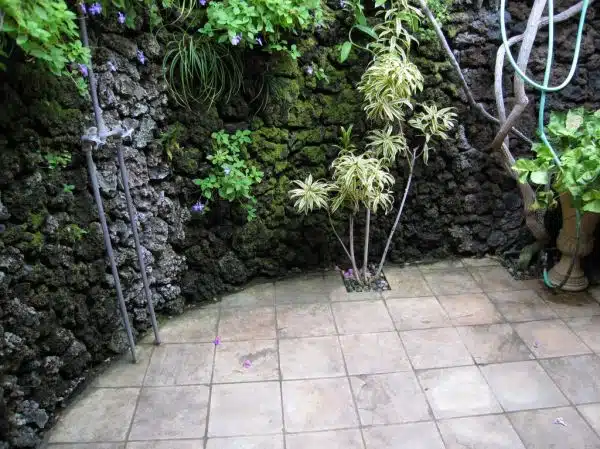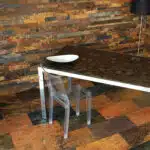Grouting outdoor tile can be a daunting task for many homeowners. However, it is an essential step in the installation process as it provides stability and durability to the tiles. Grout also prevents moisture from seeping underneath the tiles, which can cause damage over time. As a specialist in outdoor tile grouting, I have come across various challenges and learned effective techniques that produce long-lasting results.
In this article, I will share my knowledge on how to grout outdoor tile effectively. From selecting the right type of grout to preparing the surface, I will guide you through each step of the process to ensure your tiles are installed correctly. Whether you are a DIY enthusiast or looking to hire a professional, this article will provide valuable insights into achieving a flawless finish on your outdoor tile project. Let’s get started!
Preparing The Surface For Grouting
Picture yourself standing in your backyard, looking at the beautiful outdoor tile you’ve installed. But before you can enjoy the finished product, you must first take some necessary steps to prepare for grouting. Surface preparation techniques are critical to achieving a successful grout application.
The first step is to ensure that your surface is clean and free of debris or other contaminants. Pre grouting cleaning methods include sweeping away dirt and dust using a broom or vacuum, washing with soap and water, and using a specialized cleaner to remove stubborn stains or buildup. It’s essential to wait until the surface is entirely dry before proceeding with the next step.
Next, inspect your tile surface for any cracks, chips, or uneven areas that may need repair before applying grout. Fill in any gaps or holes with an appropriate filler material according to the manufacturer’s instructions. Allow time for the filler material to dry completely before moving on to the next step.
Now that your surface is clean and repaired as needed, it’s time to proceed with preparing for grouting by ensuring that all edges are taped off correctly. Use painter’s tape around any surfaces where grout should not go, such as fixtures or adjacent walls. With these steps complete, we can now move on to choosing the right type of grout for our outdoor tile project.
Choosing The Right Type Of Grout
Choosing the Right Type of Grout is crucial when it comes to grouting outdoor tile. You want a grout that can withstand harsh weather conditions, resist mold and mildew growth, and keep your tiles in place for years to come. There are two main types of grout: cement-based and epoxy-based.
Cement-based grout is the most common type used for outdoor tiling projects. It’s made from a mixture of cement, sand, and water. Cement-based grout is affordable, easy to use, and readily available in hardware stores. However, it’s not as durable as epoxy-based grout and requires sealing every year or so to prevent stains from penetrating the surface.
Epoxy-based grouts are becoming more popular for outdoor tile projects due to their durability and resistance to stains. Epoxy-based grouts are made from resin and hardener, making them more expensive than traditional cement-based grouts. They also require special application techniques and longer drying times than cement-based grouts. Although they may require more effort during installation, their Pros outweigh the Cons as they are less prone to cracking or shrinking over time compared to cement-based ones. Color options for epoxy-based grouts tend to be richer than those of cement-based ones too.
Now that you know about the Pros and Cons of each type of grout, it’s time to consider Color Options for your outdoor tile project. The color of your grout can make a significant impact on the finished look of your tilework. If you want a seamless look that blends with the tiles’ color, go for a matching shade or one shade lighter than your tiles’ darkest point. On the other hand, if you want your tiles’ design elements to pop out visually, choose a contrasting color like black with white tiles or grey with beige tiles.
After choosing the right type of grout based on its Pros & Cons along with selecting an appropriate Color Option, the next step is Calculating the Amount of Grout Needed for your project. With that said, let’s delve into how to determine the amount of grout needed for your outdoor tile project.
Calculating The Amount Of Grout Needed
- Accurate calculation of the amount of grout required for outdoor tile projects is dependent upon obtaining the exact size of the tile.
- Establishing the size of the tile is necessary for calculating the total surface area of the tiled area, which can be multiplied by the desired grout joint width to determine the total volume of grout needed for the project.
- It is important to take into consideration the size of the grout joint, as this will affect the total amount of grout required for the project.
- Once the surface area and grout joint width have been determined, an accurate calculation of the amount of grout needed can be made to ensure the successful completion of the project.
Determining Tile Size
As a specialist in outdoor tile grouting, one of the most important factors to consider when calculating the amount of grout needed is determining the size of the tiles being used. Tile size plays a crucial role in deciding how much grout will be required for your project. The larger the tile, the less grout will be needed, as there will be fewer gaps to fill between them.
Another aspect to consider when determining tile size is tile spacing. The space left between each tile can also impact how much grout is needed. A smaller gap between tiles means that more grout will be required to fill in those spaces. On the other hand, larger gaps require less grout but can result in an uneven appearance if not done correctly. It is important to note that different tile patterns may require different spacing, so it is important to consult with a professional before making any decisions.
In conclusion, when calculating the amount of grout needed for outdoor tiling projects, determining tile size should always be considered as one of the main factors. Paying attention to both tile size and spacing can help ensure that you have enough grout for your project while also avoiding any unnecessary waste or expenses. As an outdoor tile specialist, I highly recommend seeking professional advice before beginning any tiling projects to ensure that you achieve the best possible results.
Calculating Grout Volume
When it comes to tiling projects, one of the most crucial factors to consider is how much grout will be needed. Determining the amount of grout required involves several considerations, including the size and spacing of the tiles being used. However, it is also important to calculate the volume of grout needed for the project accurately.
Calculating grout volume can be a bit tricky, but it’s essential to ensure that you don’t run out of grout in the middle of your project or end up with too much leftover. To determine the amount of grout needed for your project, you will need to know the total square footage that needs to be covered. Additionally, you should factor in aspects such as the desired grout color and consistency.
The color and consistency of your grout can impact how much is needed for your project. Darker colored grouts may require more material than lighter ones as they tend to dry out faster and require more coverage. Similarly, thicker or more viscous mixes may require less overall volume due to their ability to fill gaps better than thinner ones. By considering these factors when calculating grout volume, you can ensure that you have enough material on hand while minimizing waste and expense.
Mixing The Grout
Imagine you have finally laid down the last outdoor tile on your patio, and now it’s time to mix the grout. Prior to mixing, it is essential to check that the tiles are clean and free of any debris. This is because dust or dirt can affect the grout’s ability to adhere properly, leading to a less durable finish. Once you have cleaned the surface thoroughly, you can begin mixing.
Grout consistency plays a crucial role in achieving a successful outcome. The mixture should be thick enough to stick to the tiles when applied but not too thick that it becomes difficult to work with. To achieve this sweet spot consistency, start by adding water gradually as you mix until you attain a texture similar to toothpaste. Remember that different types of outdoor tiles may require different grout consistencies.
When mixing the grout, there are specific tools that one might need. A rubber float is an essential tool for applying the grout onto the surface of the tiles evenly. However, keep in mind that it’s important not to overwork the mixture as this could weaken its structure and cause cracking once dried. Additionally, using a margin trowel will make scooping up and spreading small amounts of grout easier while minimizing messes on your outdoor tile surface.
Now that we have discussed how important proper grout consistency is and what tools might be necessary for mixing let us move forward into discussing how best to apply said mixed grout onto your newly tiled patio surface without creating unnecessary messes or errors in application technique.
Applying The Grout
After mixing the grout, it’s time to apply it to the outdoor tile. Before starting, make sure that all surfaces are clean and free of debris. Also, ensure that the weather is dry and mild, as rain or high humidity can affect the outcome of the grouting process.
When it comes to applying grout, there are various tools you can use. The most common ones include a rubber float, a grout bag, or a squeegee. Each tool has its advantages and disadvantages depending on the type of tile you’re working with. It’s best to consult with a professional or supplier before choosing which tool to use.
Another factor to consider is the color of the grout. Grout color options vary from light shades to dark ones and even bright colors for those who want to add some personality to their outdoor space. It’s essential to choose a color that complements your tiles’ hue while also considering factors such as sunlight exposure and foot traffic in your outdoor area.
To ensure optimal results when grouting outdoor tiles, using the best tools and choosing the right color of grout is crucial. Make sure you consult with an expert in this field before starting your project. In our next section, we’ll discuss how cleaning your tiles before grouting is vital for achieving impeccable results in your outdoor space.
Cleaning The Tiles Before Grouting
Imagine a beautiful outdoor space that is marred by dirty, grime-covered tiles. It’s like a painting that has been ruined by an errant brushstroke. In order to ensure that your outdoor tile installation looks its best, it’s crucial to take the necessary steps for pre-grouting preparation. One of the most important steps is cleaning the tiles before grouting.
Cleaning techniques are critical in preparing tiles for grouting. The first step is to remove any dirt or debris from the surface of the tiles. This can be achieved using a variety of methods, including sweeping, vacuuming, or wiping with a damp cloth. Next, it’s important to use a cleaning solution that is safe for outdoor tile surfaces and won’t cause damage or discoloration. A mixture of water and vinegar is an effective natural cleaning solution.
To ensure proper adhesion between the grout and the tiles, it’s essential to clean them thoroughly before beginning the grouting process. Here are some tips for pre-grouting preparation:
- Use a stiff-bristled brush to scrub away any dirt or debris.
- Avoid using harsh chemicals or abrasive cleaners that may damage the tile surface.
- Rinse tiles thoroughly with clean water and allow them to dry completely before proceeding with grouting.
- Inspect each tile carefully for any cracks or chips that may need repair before continuing with the installation.
Now that you have properly cleaned your outdoor tiles in preparation for grouting, it’s time to move on to using a grout float.
Using A Grout Float
In order to properly grout outdoor tile, it is important to use a grout float. The float should be prepared by ensuring that it is free of debris and debris-filled nooks, and that the float is dampened before use. Grout should then be applied with the float, using a light pressure and a circular motion to ensure the grout is evenly distributed. Finally, the excess grout should be removed from the tile with the float, using a wiping motion.
Preparing Floats
As an outdoor tile grouting specialist, I know the importance of preparing floats before using them for grouting. Floats are essential tools used in applying and spreading grout over your outdoor tiles. They come in different sizes and shapes, and their maintenance is crucial to ensure they remain effective during your project. Proper float maintenance is necessary to prevent sticky or clogged floats from affecting the quality of your work.
Before starting on your project, inspect your floats carefully to ensure they are free from any damages or defects that can affect their performance. Look out for cracks, chips, or worn-out edges that may cause scratches on your tiles. If you notice any damage, consider replacing them with alternative floats such as rubber or foam ones that are gentler on tiles. Cleaning your floats after each use with water and a mild detergent will also help maintain their quality.
Alternatives to traditional floats include sponges, which can be useful for smoothing out excess grout from tile surfaces without scratching them. Rubber squeegees are also effective alternatives that aid in removing excess water from tiles during cleaning. Remember not to press too hard when using these alternatives to avoid damaging the tiles’ surface. Preparing your floats before use ensures efficiency and effectiveness in applying grout over outdoor tiles while protecting them from potential damage caused by defective tools.
Applying Grout
As an outdoor tile grouting specialist, I understand the importance of applying grout correctly to ensure your tiles remain stable and durable. Grout is a mixture of cement, sand, and water used to fill gaps between tiles and prevent debris from accumulating. When applied correctly, it provides an even surface that protects your tiles from damage caused by moisture or impact. Grout color options are also available to match your desired aesthetic.
When applying grout, it is essential to use the right tools and techniques to achieve optimal results. Start by mixing the grout according to manufacturer instructions and allow it to cure for at least 10 minutes before application. Use a grout float to spread the mixture over the tiles, ensuring all spaces are filled evenly. Be sure to work in sections as you go along, wiping off any excess immediately with a damp sponge.
Tips for grouting in cold weather include keeping the grout warm during storage and application and avoiding direct exposure to cold air drafts or temperatures below 50°F. Ensure the area is well-ventilated while working and protect yourself with appropriate gear such as gloves and masks. By following these tips and using proper techniques, you can achieve optimal results when applying grout over your outdoor tiles.
Removing Excess Grout
After applying the grout, it is essential to remove any excess material on the surface of your outdoor tiles. This process is critical because leaving excess grout on your tiles can lead to unsightly discoloration and uneven surfaces. Using a grout removal tool, carefully scrape off any excess material from the surface of your tiles.
Next, apply a grout sealant to protect your newly-grouted outdoor tiles from moisture and stains. Grout sealant creates an invisible barrier over your tiles’ surface, preventing water and other liquids from penetrating into the grout lines. This step is crucial in maintaining the color and integrity of your newly-installed tile work.
Remember that removing excess grout and applying a sealant are crucial steps in achieving a beautiful, long-lasting outdoor tile installation. By using proper grout removal tools and sealants, you can ensure that your outdoor tile project remains durable and looking its best for years to come.
Transition: Now that you’ve removed any excess grout and sealed your outdoor tiles, it’s time to move onto the next step: letting the grout dry completely before cleaning up any remaining residue.
Letting The Grout Dry
Once you have finished applying the grout, it is essential to let it dry completely before moving on to the next step. Drying time will depend on various factors such as humidity, temperature, and the size of the tiles. Typically, outdoor tile grouts take around 24-48 hours to dry completely. It’s crucial to avoid walking on or using the area until the grout has dried entirely to prevent any damage.
During this drying period, it’s crucial to keep moisture away from the newly grouted area. Avoid cleaning or exposing them to any water source for at least two days after application. Moisture can cause uneven drying and discoloration of the grout lines, which can affect its long-term durability and lifespan. Use caution when watering nearby plants or allowing pets in the area.
After allowing ample time for drying, inspect the grout lines closely for any cracks or gaps that may have formed during application or drying. Address these issues immediately by adding more grout if necessary before proceeding with sealing. If everything looks good, move onto the next step: sealing the grout to protect your newly tiled outdoor area from wear and tear caused by weather exposure and foot traffic.
Sealing The Grout
Now that you have successfully grouted your outdoor tiles, the next step is to seal the grout. This is a crucial step in ensuring that your tiles look their best for years to come. As an outdoor tile grouting specialist, I cannot stress enough how important it is to seal your grout as soon as it has fully cured.
By sealing the grout, you are preventing moisture from penetrating and causing damage to the tiles and the substrate. It also prevents dirt and debris from settling into the grout lines, which can cause discoloration over time. To ensure maximum protection, it is recommended that you reapply sealant every six months to a year, depending on weather conditions and foot traffic.
Preventing grout discoloration should be a top priority when sealing your outdoor tile project. A high-quality sealer will protect against stains caused by spills or natural elements such as rain or snow. Choose a sealer specifically designed for outdoor use and make sure to follow the manufacturer’s instructions carefully. With proper maintenance and care, your outdoor tile project will remain beautiful for years to come. Speaking of maintenance, let’s move onto the next step: maintaining the grout.
Maintaining The Grout
Once the grout has been applied and allowed to dry, it is important to maintain its appearance and integrity. One of the first things to consider is grout color options. The color of the grout can greatly affect how dirt and debris are visible on the surface. For outdoor tiles that are exposed to harsh weather conditions, a darker grout color may be more practical as it will hide stains better than a lighter color.
In order to keep the grout looking its best, regular cleaning is necessary. There are many grout cleaning tools available that can make this task easier. A stiff-bristled brush or an old toothbrush can be used to scrub away dirt and debris. Specialized grout cleaners that are safe for outdoor use can also be used for deeper cleaning.
Proper maintenance of your outdoor tile grouting will help extend its lifespan and prevent common problems from occurring. However, even with proper care, issues may arise such as cracking or discoloration. In the next section, we will discuss some troubleshooting tips for these common grouting problems so you can keep your outdoor tiles looking their best.
Troubleshooting Common Grouting Problems
Maintaining the grout is crucial to ensuring the longevity of your outdoor tile. However, even with proper maintenance, common grouting mistakes can still occur. One mistake is not mixing the grout properly, which can result in weak and crumbly grout. Another mistake is applying too much water during the cleaning process, which can weaken and erode the grout over time. Lastly, not allowing the grout to dry completely before sealing it can cause discoloration and a hazy appearance.
To troubleshoot these common grouting mistakes, there are a few tips you can follow. If you notice weak or crumbly grout, try adding more water to your mix and remixing it thoroughly before applying. If you’ve already applied too much water during cleaning, use a wet vac or towels to remove excess moisture before it has a chance to soak into the grout. Lastly, if you’ve sealed your grout too soon and it appears hazy or discolored, try using a commercial sealer stripper followed by resealing when it’s completely dry.
Taking these troubleshooting tips into consideration will help ensure that your outdoor tile is properly maintained for years to come. However, if you find that you’re still having trouble with your outdoor tile grouting despite following these tips, consider hiring a professional grouter for assistance.
- Use distilled water instead of tap water when mixing your grout for better consistency.
- Apply a sealer after allowing your grout to dry completely to prevent future discoloration.
- Don’t wait too long after laying your tile to begin the grouting process as this can lead to cracking and unevenness in your finished product.
Hiring a professional grouter may be necessary if you’re experiencing persistent issues with your outdoor tile’s appearance or functionality. They have specialized knowledge and tools that can help identify underlying problems and provide effective solutions that will save you time and money in the long run. Don’t hesitate to reach out for help if you need it.
Hiring A Professional Grouter
- Grouters are professionals who are experienced in the process of outdoor tile grouting, and hiring a professional to complete a grouting job can have a number of benefits.
- The cost of hiring a professional grouter will depend on the materials used, the size of the job, and the experience of the grouter.
- Before hiring a professional grouter, it is important to assess the job, create a budget, and research potential grouters.
- Checking the credentials of potential grouters is an important step in the hiring process, as grouters should be certified and insured.
- Once a grouter has been chosen, it is important to discuss the job, materials, and budget with the grouter in detail.
- Finally, a written contract should be signed detailing the job, materials, timeline, and cost before beginning the grouting work.
Benefits Of Hiring A Professional
When it comes to outdoor tile grouting, there are many benefits to hiring a professional. One of the main advantages is that professionals have the knowledge and experience necessary to complete the job efficiently and effectively. They have access to specialized tools and equipment that can make the process faster and more precise, which can save you time and money in the long run.
Another benefit of hiring a professional grouter is cost effectiveness. While you may think that doing it yourself will save you money, inexperienced DIY attempts can often result in mistakes that end up costing more in repairs or replacements. Professionals also know how to work within your budget, helping you choose the right materials and techniques for your project.
Overall, choosing to hire a professional grouter for your outdoor tile project can provide numerous benefits. Not only will they ensure that your tiles are properly installed and maintained, but they can also help increase the longevity of your investment. So if you’re looking to complete a high-quality, cost-effective outdoor tile project, consider hiring a professional grouter today.
Cost Of Hiring A Professional
When it comes to outdoor tile grouting, homeowners often question whether hiring a professional is worth the cost. The answer depends on several factors, including the pros and cons of DIY vs professional grouting and the cost vs quality trade-off. While doing it yourself may seem like a cheaper option, inexperienced attempts can lead to costly mistakes. On the other hand, hiring a professional can ensure that your tiles are installed correctly and maintained properly, which can increase their longevity and save you money in the long run.
One of the best times to hire a professional grouter is before installation. Professionals have experience in selecting the right materials and techniques for your project, which can help you avoid costly mistakes down the line. They also have access to specialized tools and equipment that can make the process faster and more efficient, saving you time and money. However, if you’ve already started a DIY project and encountered difficulties or errors, it’s not too late to call in a pro to fix the problem.
When comparing outdoor tile grouting with indoor tile grouting, there are some key differences in terms of cost. Outdoor projects typically require weather-resistant materials that are more expensive than those used for indoor projects. Additionally, outdoor projects may require more labor due to their size or complexity. However, investing in a professional grouter who knows how to work within your budget can still provide cost-effective results that enhance your home’s value and curb appeal for years to come.
Steps For Hiring A Professional
When it comes to outdoor tile grouting, hiring a professional is often the best decision for homeowners who want to ensure that their project is done correctly. However, finding the right contractor can be a daunting task. To make the process easier and more efficient, there are several steps that homeowners can take to find reputable contractors and get accurate cost estimations for their projects.
The first step in hiring a professional grouter is to research local contractors in your area. Look for companies that specialize in outdoor tile grouting and have experience with similar projects. Check online reviews and ratings, as well as references from past clients. This will help you narrow down your options and find reputable contractors who can provide quality workmanship at a fair price.
Once you’ve identified potential contractors, schedule consultations with each one to discuss your project and get cost estimates. During these meetings, ask detailed questions about materials, techniques, timelines, and warranties. A reputable contractor should be able to provide clear answers and explain any potential risks or challenges associated with your project. By comparing multiple cost estimates and evaluating each contractor’s level of expertise and professionalism, you can make an informed decision about which contractor will best meet your needs.
Grouting Outdoor Tile On A Budget
As an outdoor tile grouting specialist, I understand that not everyone has the budget to use premium grout options for their outdoor tiling needs. Fortunately, there are several budget-friendly grout options available that can still provide excellent results. One such option is using sanded grout, which is typically cheaper than unsanded grout and can be used for larger joints. Another alternative method for grouting outdoor tile on a budget is using epoxy grout, which is water-resistant and durable.
Using a sanded grout can save you money while also providing the necessary strength and bonding properties required for outdoor tile installations. It’s important to note that while sanded grouts are usually more affordable than unsanded ones, they have limitations in terms of joint width and tile spacing. Epoxy grouts, on the other hand, provide a more versatile solution for outdoor tile installations as they are resistant to moisture and stains.
In conclusion, there are several budget-friendly options available when it comes to outdoor tile grouting. Whether you choose to use sanded or epoxy grouts will depend on your specific requirements and preferences. By exploring these alternatives methods of grouting outdoor tile within your budget limits, you can still achieve great results without breaking the bank. In the subsequent section, we will address some frequently asked questions about outdoor tile grouting that may help you further in your tiling endeavors.
Frequently Asked Questions About Outdoor Tile Grouting
Like a painter applying the final brushstrokes to a masterpiece, grouting outdoor tile is like adding the finishing touches to your outdoor living space. It brings everything together and creates a cohesive look. However, grouting can be tricky, and if done incorrectly, it can ruin all of your hard work. In this section, we will discuss common mistakes and best practices for grouting outdoor tile.
One of the most common mistakes made when grouting outdoor tile is not mixing the grout correctly. It’s important to follow the manufacturer’s instructions carefully and ensure that you are using the correct amount of water. If you add too much water, the grout will be too thin and won’t set properly. On the other hand, if you don’t add enough water, the grout will be too thick and difficult to work with.
Another mistake people make is not cleaning up excess grout before it dries. Once the grout has set, it can be challenging to remove without damaging the tile surface. To avoid this problem, use a damp sponge or cloth to wipe away any excess grout as soon as possible after applying it. Best practices also include sealing your outdoor tile after grouting to protect against moisture and stains.
Grouting outdoor tile requires patience and attention to detail, but with these best practices in mind and by avoiding common mistakes, you can achieve beautiful results that will last for years to come. Remember always to read manufacturer’s instructions carefully before beginning any project!
Conclusion
Properly grouting outdoor tile requires careful preparation, attention to detail, and the right tools. Before beginning any grouting project, it is essential to properly clean and prepare the surface to ensure a strong bond between the tile and grout. Choosing the right type of grout and calculating the necessary amount is also crucial for a successful outcome.
When applying the grout, it is important to work in small sections and use a rubber float to push the mixture into any gaps or spaces between tiles. Common grouting problems such as cracking or discoloration can often be avoided with proper technique and maintenance.
As an outdoor tile grouting specialist, I know firsthand the importance of a well-executed grouting job. It not only enhances the appearance of your outdoor space but also serves a functional purpose in protecting your tiles from moisture damage. By following these steps and taking proper care throughout the process, you can achieve a beautiful and long-lasting result that will elevate your outdoor living space for years to come. Happy tiling!
Image Credits
- “Outdoor shower, slate tiles” by troymckaskle (featured)





























